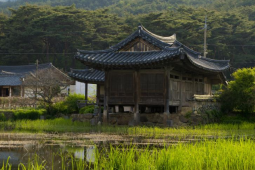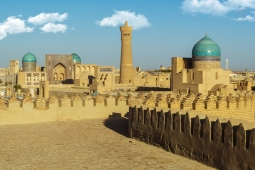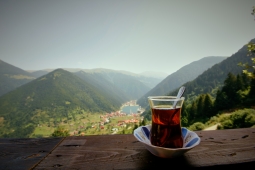Cultural Selection: The Silk Roads Legacy of the Ajanta Cave Paintings
©PNP! CC BY-NC-ND 2.0The artistic traditions which flourished and influenced one another along the Silk Roads were rich and varied. Amongst the earliest of these was the far reaching spread of Buddhist religious art. The Ajanta caves, an archaeological site consisting of around 30 rock cut caves, situated in the Northwest of the Indian Subcontinent, 100km northeast of what is today the city of Aurangabad, exemplify the influence of this artistic style and its enduring legacy throughout the Silk Roads.
This extensive network of rock cut caves once functioned as a mixture of Buddhist monasteries and sanctuaries. Preserved within them are some of the best surviving examples of ancient Buddhist art with each cave originally decorated with sculpture, wall murals, and ceiling paintings. What remains at the site today is a window into an artistic tradition which spread across vast areas of the Silk Roads influencing many others, particularly within the realm of mural painting. The majority of the painting and sculpture at Ajanta depicts stories from the births of the previous lives of the Buddha, however they also include an array of human figures, animals, and other designs from the natural world. As the murals are amongst the best preserved examples of painting and sculpture from the Indian sub-continent the Ajanta caves serve as a primary point of reference for subsequent artistic production along the Silk Roads including in parts of Central Asia, the Himalayas, Japan, Southeast Asia, and China.
The Ajanta caves date from the 2nd century B.C.E. to 650 C.E and were cut into the mountainside in two distinct phases. The oldest murals, although less well preserved, are some of the oldest Buddhist paintings in existence. The most exquisite and well preserved of the Ajanta murals date from much later, during the 5th century Gupta period. At this time, artistic traditions within the Indian Subcontinent were flourishing, with artistic representations and compositional elements that were elegant in form and conceptual idealism. In a style similar to that of much later European fresco painting, the Ajanta murals showcase incredible skill in the painting of facial expression, gesture and pose. The murals are painted in what would go on to become a style distinct to the Indian subcontinent but with some elements such as the use of perspective, lime mortar, and the three quarter profiles of the figures, suggesting a Hellenistic (Ancient Greek) influence. Notably, many of the colour pigments used in the painting, including red ochre, yellow ochre, brown ochre, black, white, and lapis lazuli were likely imported from Central Asia and the Iranian Plateau.
From as early as 475 CE the caves were well known and frequently visited by travellers including Buddhist pilgrims, monks, and traders. The murals themselves are a rich source of knowledge of the cultural interactions taking place in the region at the time. Exemplifying the cosmopolitan nature of Buddhism during this period, it has been hypothesised that a number of people from other regions and cultures are depicted on the murals including figures believed to be Sassanian merchants, painted wearing vibrant blue socks and negotiating a transaction. Cave 1 contains a fresco with additional figures dressed in clothes from distant lands reflecting the prosperous and multicultural society of the 5th century CE that engaged readily in trade. It has been further suggested that lapis lazuli was specifically used to identify foreigners within the murals and used to paint their clothing. Further scenes in the murals appear to show a variety of colourful textiles which were a major import during the Gupta period.
Furthermore, the inheritors of the Ajanta pictorial tradition are varied and many of the painting’s decorative elements, including mandalas, monstrous creatures, Bodhisattvas, and Buddhas have left an indelible imprint on artistic creations throughout the Silk Roads, and beyond. There are numerous examples in modern day Afghanistan, some of the most prominent being sites at Bamiyan, Foladi, and Kakrak. Other examples have been found throughout the Northern Indian Subcontinent and the Himalayas – primary points from which this art style later spread. A technique of portable paintings subsequently developed, popularised by the export of Buddhist texts throughout Asia which were essential in the spread of the associated artistic tradition and iconography. Additionally, the Ajanta tradition also fused with Chinese painting giving rise to a distinct new artistic style.
The expansion of the Ajanta artistic style is a testament to the dynamic intercultural exchanges among those along the Silk Roads, and beyond. Pronounced similarities in iconography, technique, and style reflect the transnational fluidity and cross-cultural appeal of the art found at Ajanta. Certain elements of the style were clearly taken up in other regions along the Silk Roads including compositional elements such as delicate flowers whose influence can be seen in Chinese and Japanese painting. Additional recurring motifs from the animal world became popular in other artistic traditions such as the inclusion of monkeys and camels being led through the desert.
See Also

Intercultural Design Elements in Relief Sculpture from Silla, the Korean Peninsula
From the 7th century onwards the city of Gyeongju, the capital of Silla during the Three Kingdoms (57 BCE – 668 CE) and later Unified Silla (668 – 935 CE) periods, developed to become a major trade centre in the Korean Peninsula.

Architectural Design in Urban Centres along the Silk Roads from the 7th to the 14th century CE
Cities and urban centres flourished along the Silk Roads passing through the Central Asian regions of Khorasan (in present-day North East Iran) and Transoxiana (a portion of Central Asia, that includes parts of present day Uzbekistan, Tajikistan, southern Kyrgyzstan and southwest Kazakhstan) between the 7th and 14th centuries CE.






